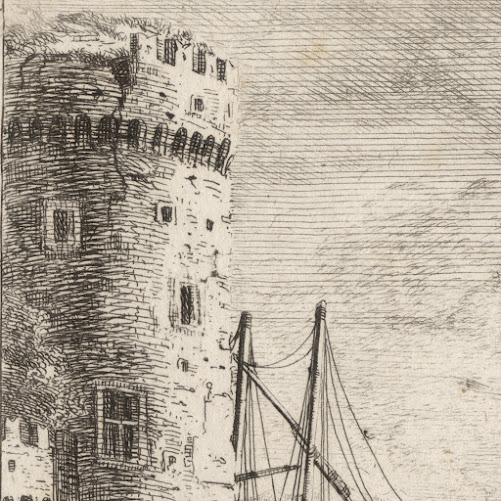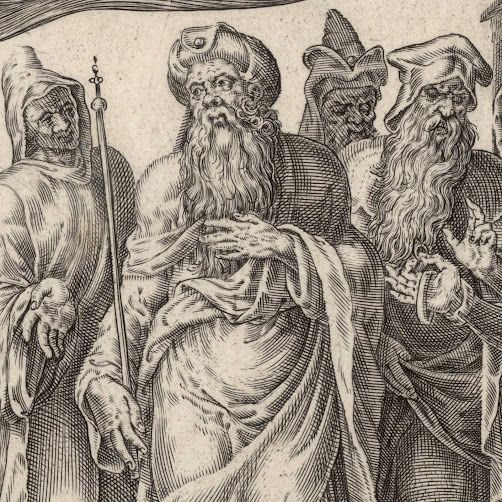Cornelis Bloemaert (1603–1692) in collaboration with
Theodor Matham (aka Dirk Matham) (1605/06–1676) (background landscape)
Note: Based on the description
offered by Archive.org, I understand that Cornelis Bloemaert also engraved the
same design in reverse in another plate (c1676); see https://archive.org/details/tableauxdutemple00maro/page/n557/mode/2up.
“Tantale” (as titled on plate),
c1655, after the design by Abraham van Diepenbeeck (aka Abraham van Diepenbeek; Abraham van Diepenbeke)
(1596–1675), plate 54 in the series of 58 illustrations to Michel de Marolles’ (1600–1681) “Tableaux
du Temple des Muses” (aka “Tableaux du temple des muses tirez du cabinet de feu
Mr Favereau, et gravez en tailles-douces par les meilleurs maistres de son
temps pour représenter les vertus et les vices, sur les plus illustres fables
de l'antiquité, avec les descriptions, remarques et annotations”), published by
Nicolas Langlois in Paris in 1655. This impression
may be from a later date as it is inscribed on the plate with the number, “57”.
Etching and engraving on laid paper.
Size: (sheet) 32.5 x 22.7 cm; (plate)
27.4 x 18 cm; (image borderline) 23.3 x 17.6 cm.
Numbered and lettered on plate below
the image borderline: (left) “Tantale”; (centre) [two lines of Greek from Homer's
Odyssey] HOMER. Odyss. XI.”; (right) “54”.
The British Museum offers the
following description of this print:
“Mythological scene with Tantalus in
a river trying to reach for some fruits on a tree at left, Hell in left
background; after Abraham van Diepenbeeck; illustration on page 427 from
Marolles' "Temple des Muses" (Paris, Nicolas Langlois: 1655).
c.1635-1638”
(https://www.britishmuseum.org/collection/object/P_1973-0616-52).
Note: the BM references this print
in Marcel Roethlisberger’s “Abraham Bloemaert and His Sons” (1993) with cat.
no. “CB11”, but this reference is incorrect as CB11 is the cat. no. for “The
Slaying of the Niobids” (see vol. 1, p. 524).
Condition: strong impression but with
a printer’s crease on the right. The sheet is in an excellent condition with no
tears, holes, losses, abrasions, significant stains or foxing.
I am selling this pair of etchings based
on the same design, but executed by different artists with a gap of around 75
years separating them, for AU$334 in total for the pair (currently US$255.55/EUR208.40/GBP188.81
at the time of posting this listing) including Express Mail (EMS) postage and
handling to anywhere in the world, but not (of course) any import duties/taxes
imposed by some countries.
If you are interested in purchasing this
amazing pair of superb quality etchings, please contact me
(oz_jim@printsandprinciples.com) and I will send you a PayPal invoice to make
the payment easy.
This pair of prints has been sold







Bernard Picart (1673–1733)
“Tantalus’ Torment” (aka “Tantalus
in Hades”), 1730, after the engraving by Cornelis Bloemaert and Theodor Matham after
the design by Abraham van Diepenbeeck,
first
published in Amsterdam by Zacharias Chatelain
(fl.1705–1749) in 1733 in “Le temple des muses: orné de LX tableaux où sont
représentés les evenemens les plus remarquables de l'antiquité fabuleuse” (The
temple of the muses: decorated with 60 illustrations representing the most
remarkable events of fabulous antiquity), plate inset between pages 142 and 143
(see https://archive.org/details/gri_33125012263162/page/n265/mode/2up).
Etching and engraving in two plates
(an outer frame plate and an inner image plate) on laid paper.
Size: (sheet) 46.4 x 28.6 cm; (outer
plate) 35.5 x 25.7 cm; (image borderline) 34.2 x 24.4 cm.
Lettered on plate below the image: “B.
Picart dir. / TANTALE CONDAMNÉ À SOUFFRIR LA FAIM & LA SOIF, │Des Tantalus Bunderbahre bestrafung / MALGRÉ LES
FRUITS & LES EAUX QUI L’ENVIRONNENT. │Tantalus
midden onder Vrugten en Wateren, / Tantalus’s torment. │tot honger en dorst verweesen.”
The British Museum offers the
following description of this print:
“Tantalus in Hades, standing in
shoulder-deep water, tries to pick up some fruits from a tree; in ornate frame,
with winds on each side, and peacock in the lower part, printed from a separate
plate; plate LVI to 'Le Temple des Muses' (first published Amsterdam:
Chatelain, 1733). c.1730/33”
(https://www.britishmuseum.org/collection/object/P_1914-0214-214).
Condition: strong, near faultless
impression in near pristine condition with no tears, holes, folds, losses,
abrasions, significant stains, foxing or signs of handling.

















































